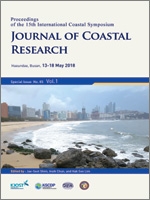Kim, Y.-T.; Park, J.-H.; Choi, B.-H.; Kim, D.H., and Kwon, H.-H., 2018. A Bivariate Frequency Analysis of Extreme Wave Heights and Periods Using a Copula Function in South Korea. In: Shim, J.-S.; Chun, I., and Lim, H.S. (eds.), Proceedings from the International Coastal Symposium (ICS) 2018 (Busan, Republic of Korea). Journal of Coastal Research, Special Issue No. 85, pp. 566–570. Coconut Creek (Florida), ISSN 0749-0208.
Sea storms are generally described by a set of variables such as wave height, wave period and wave direction, and these random variables are typically treated as independent of one another. Moreover, univariate wave frequency analysis has been applied to estimate design wave heights corresponding to various return levels (e.g. 20, 50 and 200-year) using significant wave heights under stationary conditions. However, it has been acknowledged that these variables are often correlated with each other, and such dependence structure needs to be considered in the estimation of extreme quantiles. More specifically, a joint estimation of quantiles for different combinations of these variables such as wave heights and wave periods is required to reliably assess optimal design of coastal (or offshore) structures. Over the last several decades, accelerated sea level rise (SLR) and its impact on coastal areas have been reported in many parts of the world. Estimation of extreme quantiles of SLR as a nonstationary process play a crucial role in assessing these impacts. In these contexts, a multivariate frequency model using a copula function approach is introduced to describe sea storm risk, which is mainly characterized by wave heights and periods. The proposed multivariate frequency analysis offers several advantages over widely used univariate stationary frequency analysis including uncertainty estimation, improved representation of inter-dependency and significant improvement of compound risk estimation.





